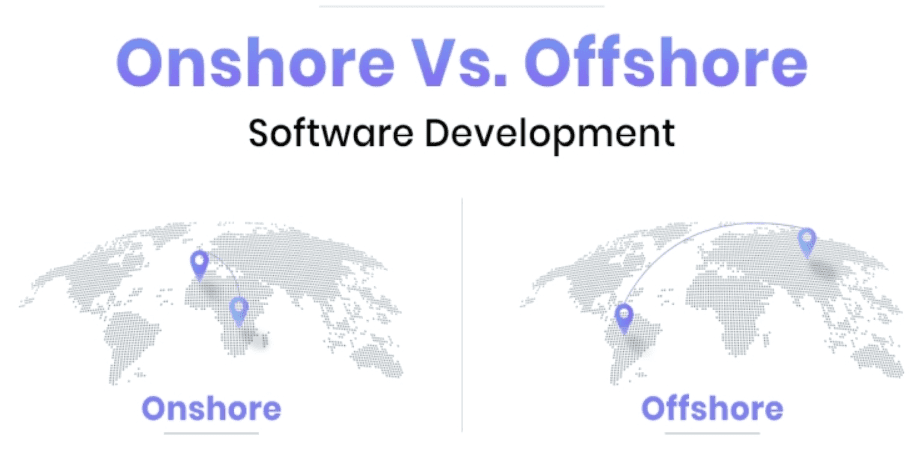With the aim of reducing costs, efficient scaling, and accessing global talent, outsourcing software development has become a popular choice for businesses. Most organizations, however, seem indecisive in identifying the proper option that will address their requirements when at the crossroads of the nearshore-offshore dilemma. Both outsourcing models have unique benefits, but they come with their own cons.
What is Nearshore Software Development?
It is an offshore software development in which outsourcing of software projects is done in the company of neighboring or bordering countries and sometimes in similar time zone countries. A good example is a company located in the USA that wishes to outsource the application to countries like Mexico, Colombia, or Canada. It enables close ties in communication and collaboration.
Advantages of Nearshore Software Development
Time Zone Similarity
It really has a significant advantage in that it has a short time zone difference. So, it is better for real-time exchange, avoids delays, and makes quick feedback loops.
Easier Travel and Communication
It is quite simple to organize meetings since they are closer. Transport costs are also lower. This would enhance the overall relationship between the clients and the development team.
Faster Onboarding
If nearshore teams use their geographical advantage, they can readily understand the market, culture, and goal orientation of their client. Consequently, the time to onboard a new project can be drastically minimized.
Challenges of Nearshore Software Development
Higher Costs
Though it is somewhat less costly than setting up a team of in-house developers, the cost advantages of near-shoring may be less than that of offshore development in cheaper labor-market countries.
Limited Talent Pool
While nearshore outsourcing provides access to skilled professionals very much on par with their offshore counterparts in countries like India or Eastern Europe, the availability of the talent pool may be limited. Hence, specific skill availability or niche expertise may be affected.

Best Examples of Nearshore Software Development
GlobalLogic
GlobalLogic has its origin in the U.S. and provides software development services in multiple countries in Latin America, including Mexico and Argentina. Thanks to their nearshore locations in these areas, they can work seamlessly with customers in the U.S. and elsewhere in North America.
Softtek
An IT services major, Softtek is headquartered in Mexico and serves its clients across the continent of North America and Europe in a borderless manner. Due to its ability to carry out development solutions in the same or similar time zones, its communication is unencumbered and easy and delivers high-quality results.
What is Offshore Software Development?
Offshore software development is the use of outsourcing for developmental activities to countries far distant from the client’s location, typically overseas. For example, it is when a company residing in the U.S. outsources software-related work to a country such as India, China, or the Philippines. Lower costs in labor and the broader size of labor talent become the principal advantages of offshore outsourcing.
Advantages of Offshore Software Development
Cost Saving
Cheap labor is usually associated with offshore outsourcing: Asian or Eastern European countries maintain low wages compared to North American or Western European counterparts. This presents more income opportunities for companies who wish to control development expenditures.
Talent Pool Access:
Offshore locations mean access to a bigger pool of developers with diverse skill sets. In India, Ukraine, and the Philippines, there are millions of skilled software developers, so locating the expertise required for your project should not be a problem.
Round-the-clock Development:
Outsourcing across time zones allows running a 24-hour operation. For instance, the U.S. company could have its day team work with an offshore team through the night for speedy development.
Challenges of Offshore Software Development
Communication Hurdles
The primary concern is the time zone difference. While there is a definite advantage to having teams working across the clock, it does imply that communication can be slower. There are often delays in feedback and meetings while decisions are made.
Cultural and Language Barriers
Cross-cultural misunderstandings, not always due to language but equally as much due to different attitudes toward work, communication styles, etc., are sometimes hard to bear. While most offshore teams will have a command of English, the problem lies with interpretation, especially in cases of complex project requirements.
Quality Control and Oversight
This is challenging, as an offshore team may be under completely different management. However, assuring quality of work is very much possible and upholding project timelines with strong communication, clear documentation, and robust project management. Without strong oversight, though, work quality will invariably be inconsistent.
Best Examples of Offshore Software Development
Tata Consultancy Services (TCS):
TCS, the company engaged in outsourcing on a global scale, is headquartered in India and serves clients from across the globe. This legendary company has been in existence long enough and has gathered enough respect from other venerable corporations in the case of offshore teams. TCS also presents an entire gamut of IT services, with software development as one of its core.
Accenture:
Due to offshore development in countries like India, the Philippines, and Romania, Accenture is able to deliver globally competitive services that are cost-effective, scalable, and specialized.
Nearshore vs. Offshore: Which One to Choose for Business?

Making a choice between nearshore software development and offshore software development depends on the needs, budgets, and priorities of the business. This is a brief rundown to guide you
Factors | Nearshore Development | Offshore Development |
Cost | Moderate savings | High savings |
Time Zone Synchronization | Minimal, similar time zones | Significant differences |
Communication | Easier and faster | Slower due to time zone gaps |
Cultural Alignment | High | It can vary, but often lower |
Talent Pool | Smaller but highly skilled | Large, but may require more effort to vet |
Best For | Real-time collaboration, ease of communication | Cost savings, large talent pool |
When to Choose Nearshore
- To engage in frequent communication and collaboration for the entire project.
- For work within the same time zone where real-time feedback is required.
- When similarities in culture and language are a must for project success
When to Choose Offshore
- If your primary aim is cost-cutting.
- If you require any specialized developers.
- If your comfort level extends to handling teams across disparate time zones and overcoming communication difficulties that may arise.
Summary
Both nearshore and offshore software development have their own merits and demerits. However, the preference depends mainly on your budget, the extent of coordination you require, and the project’s complexity. Nearshore would be applicable to businesses that want easier communication and closer collaboration. In contrast, offshore will serve organizations that seek even bigger cost savings and international access to software specialists.
The needs of your company must be considered before you select or compare possible options against your goals. Whichever option is chosen will guarantee your advancement, enhance your innovativeness, and keep you competitive within the rapidly changing environment of the global marketplace.
